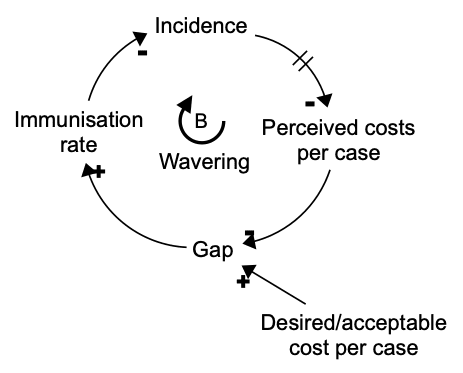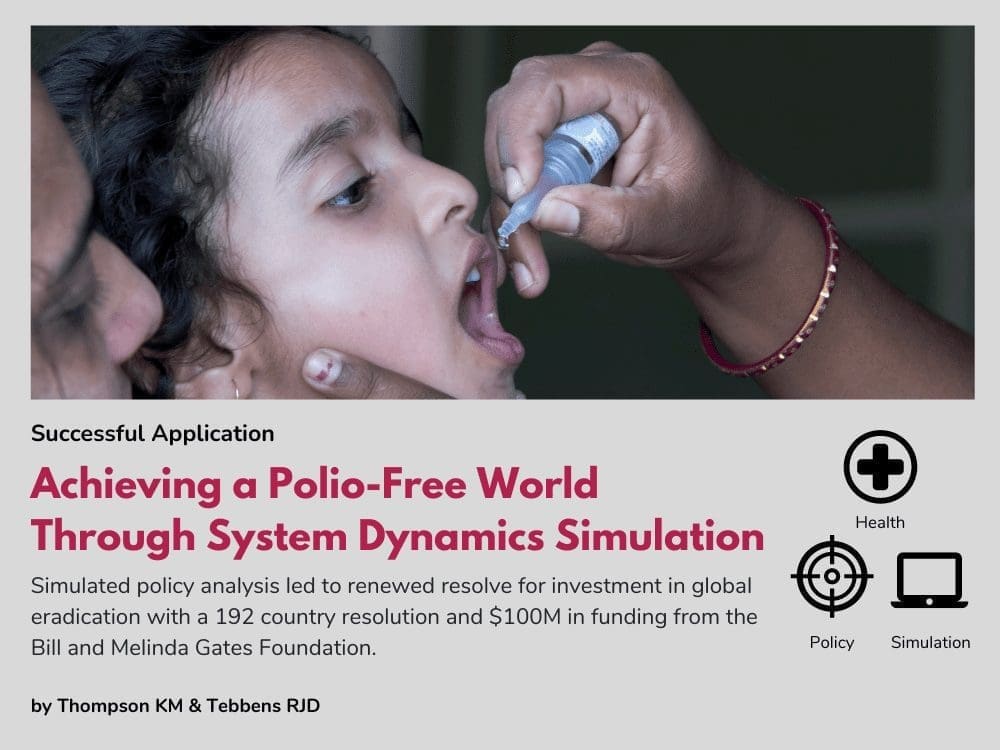Achieving a Polio-Free World Through System Dynamics Simulation
EXECUTIVE Summary
This System Dynamics model underpinned a 192 country resolution to eradicate polio globally and led the Bill and Melinda Gates Foundation to give Rotary International $100 million to fund the polio eradication effort.
The model made a case for continued funding policy eradication by providing compelling evidence that polio outbreaks will cost more than continued intense vaccination. While the reduction in the incidence of cases was making it look like the cost of immunization was exceeding its benefits, this application of System Dynamics shows that dealing with ongoing, long-term sporadic outbreaks resulting from stopping or slowing down immunization programs is even more costly than dealing with sporadic outbreaks. The process resulted in a simulation model that estimates the costs of two alternative policies. Option 1 was to continue efforts to eradicate polio and option 2 was to reduce the immunization rate and deal with sporadic outbreaks.
This analysis came at a critical time. In February 2007, the WHO Director-General, Dr. Margaret Chan, convened an urgent stakeholder consultation to discuss the option of switching from eradication to control. Clearly showing the dynamics and giving the wavering commitment a name helped key stakeholders appreciate the options quantitatively and with a much longer time horizon. Since then, efforts have continued to focus on finding the resources needed for complete eradication and on dealing with the other complex challenges that remain. With the support of the simulation model, national and global health leaders and financial supporters re-committed to completing eradication, which led to several hundreds of millions of dollars of resources.
#Polio #WHO #Vaccination #Health
The Problem
Following the successful eradication of smallpox and impressive progress in the elimination of polio in the Americas, in 1988 the World Health Assembly committed to the global eradication of wild polioviruses by the year 2000. By 2000, the Global Polio Eradication Initiative (GPEI) had significantly reduced the global circulation of wild polioviruses. However, in 2002–3, faced with insufficient funding to continue intense vaccination everywhere, the GPEI focused its vaccination efforts. At the time, wild polioviruses continued to circulate in six countries, but many other countries remained vulnerable to importation. Political and logistical challenges led to outbreaks and exportations, and between 2004 and 2006 wild polioviruses appeared again in previously polio-free African and Asian countries.
Toward the end of 2005, a debate began about abandoning the goal of eradication. How could the world continue to justify the significant use of resources (both financial and human) on polio, particularly with the number of cases globally already so low and so many other disease control and health services programs in need of resources?
The Solution
The dynamic disease outbreak model represents a more complicated version of the standard SIR model used in a popular System Dynamics textbook (Sterman, 2000). However, in Polio, we must deal with different types of imperfect immunity (i.e., from historic or recent exposure to polioviruses – including the oral poliovirus vaccine and/or vaccination with the inactivated poliovirus vaccine – as well as a latent period and routine or supplemental immunization rates). Modifying and expanding our existing model allowed us to determine that it was not possible to “effectively control” (i.e., achieve low cases) at a low cost. This means that control either implies high costs and low cases, or low costs and high cases, but not low costs and low cases.

However, our most significant insight came from exploring the dynamics of the economic investment in eradication. After watching the GPEI deal with the reintroductions of wild polioviruses in previously polio-free countries between 2004 and 2006, we recognized that reducing vaccination led the stock of susceptible individuals to build up and ultimately to outbreaks after some delay. Responding to the outbreaks requires reinvesting in intensive vaccination, which after some delay contains the outbreak and reduces or eliminates the circulation of the virus. With success comes a perception that the high level of investment compared to the low incidence is no longer justified. If policymakers succumb to the resulting pressure to reduce vaccination spending, this creates a situation in which populations again become vulnerable to new outbreaks.
“If policymakers succumb to the resulting pressure to reduce vaccination spending, this creates a situation in which populations again become vulnerable to new outbreaks.”
To capture this behavior, we constructed the negative feedback loop shown here, which we called “wavering”. We incorporated this feedback loop into our dynamic disease model and tailored the model to two populous northern Indian states in which wild poliovirus still circulates. We explored two options: (1) vaccinate intensively until eradication; and (2) vaccinate intensively only if the costs per incident case remain below a certain acceptable level, but reduce the vaccination intensity otherwise (i.e., a “control” option with the possibility of wavering).


Outcomes
This application of System Dynamics highlights the systemic causes of overruns and emphasizes the importance of understanding the complex physical and social systems within which large projects operate. We, fortunately, saw the wavering commitment loop when no one else seemed to see it, and we went beyond just seeing the loop to build and use a model that provided answers to critical questions at the time the decision makers could use them (and needed them and asked us). In the presentation to the stakeholders, we showed the results to tell the dynamic story in the simplest possible way (i.e., by comparing a firm commitment to a wavering commitment showing the cumulative costs and cases).
We did not focus on explaining the model itself to attempt to walk the decision makers through the equations or diagrams. Instead, we focused on communicating the key insights based on what they already knew (e.g., the 2002–3 reduction in vaccination led to big outbreaks and high costs). However, we anticipated and received (as anticipated) some criticism from economists who did not recognize in the model a traditional health economic analysis, but these were relatively limited.
Do you want to know more?
- Using System Dynamics to Develop Policies That Matter: Global Management of Poliomyelitis and Beyond
- Economic analysis of the global polio eradication initiative
- Economic benefits of the global polio eradication initiative estimated at $40-50 billion
- Modeling Global: Policy for Managing Polioviruses: An Analytical Journey
- Eradication versus control for poliomyelitis: an economic analysis
OTHER SUCCESSFUL APPLICATIONS
Solving Bottlenecks in Dairy Production Facilities with System Dynamics
Solving Bottlenecks in Dairy Production Facilities with System Dynamics EXECUTIVE Summary FrieslandCampina faced potential bottlenecks in production due to the merging of two factories. They hired SD&Co which employed system dynamics simulation models to predict...
A Design Value Calculator: A System Dynamics Boardgame
A Design Value Calculator: A System Dynamics Boardgame EXECUTIVE Summary Product design is a specific form of complex innovation that touches all areas of an organization’s management. While entrepreneurs recognise the value of design, they often tend to focus...
The World Bank Uses System Dynamics to Identify Root Causes of Poverty
The World Bank Uses System Dynamics to Identify Root Causes of Poverty EXECUTIVE Summary Madagascar has one of the highest poverty rates in the world. In 2022, an astonishingly three out of every four people in Madagascar lived below the poverty line. Poverty has...
Upcoming Events

MIT System Dynamics Seminar | Approaches to Encouraging Health Exchange Participation
You are invited to attend the System Dynamics Seminar being held on Friday, April 26th from 12:30-2:00pm EST in the Jay W. Forrester conference room, E62-450, or via Zoom: https://mit.zoom.us/j/94114971874 (Password: SDSP24). Our guest speaker will be Soheil Ghili...
Recent Posts
Society Governance Updates
Society Governance Updates Welcome, Allyson! New President Allyson Beall King joined the Policy Council as our 2024 President. Her primary role is as director of the Washington State University School of the Environment, which focuses on regional ecologies and our...
Call for Presenters: Seminar Series
Call for Presenters: Seminar Series We at the System Dynamics Society are continually seeking vibrant and knowledgeable presenters for our ongoing Seminar Series. As we unfold the calendar, there’s always a place for more insights, experiences, and expertise to enrich...
Honoring Excellence: A Glimpse into the Awards of the International System Dynamics Conference
Honoring Excellence: A Glimpse into the Awards of the International System Dynamics Conference The International System Dynamics Conference brings together experts, practitioners, and students to exchange ideas, showcase real-world applications, and celebrate...
Join us
OTHER SUCCESSFUL APPLICATIONS
Solving Bottlenecks in Dairy Production Facilities with System Dynamics
Solving Bottlenecks in Dairy Production Facilities with System Dynamics EXECUTIVE Summary FrieslandCampina faced potential bottlenecks in production due to the merging of two factories. They hired SD&Co which employed system dynamics simulation models to predict...
A Design Value Calculator: A System Dynamics Boardgame
A Design Value Calculator: A System Dynamics Boardgame EXECUTIVE Summary Product design is a specific form of complex innovation that touches all areas of an organization’s management. While entrepreneurs recognise the value of design, they often tend to focus...
The World Bank Uses System Dynamics to Identify Root Causes of Poverty
The World Bank Uses System Dynamics to Identify Root Causes of Poverty EXECUTIVE Summary Madagascar has one of the highest poverty rates in the world. In 2022, an astonishingly three out of every four people in Madagascar lived below the poverty line. Poverty has...
Recent Posts
Society Governance Updates
Society Governance Updates Welcome, Allyson! New President Allyson Beall King joined the Policy Council as our 2024 President. Her primary role is as director of the Washington State University School of the Environment, which focuses on regional ecologies and our...
Call for Presenters: Seminar Series
Call for Presenters: Seminar Series We at the System Dynamics Society are continually seeking vibrant and knowledgeable presenters for our ongoing Seminar Series. As we unfold the calendar, there’s always a place for more insights, experiences, and expertise to enrich...
Honoring Excellence: A Glimpse into the Awards of the International System Dynamics Conference
Honoring Excellence: A Glimpse into the Awards of the International System Dynamics Conference The International System Dynamics Conference brings together experts, practitioners, and students to exchange ideas, showcase real-world applications, and celebrate...
Upcoming Events

MIT System Dynamics Seminar | Approaches to Encouraging Health Exchange Participation
You are invited to attend the System Dynamics Seminar being held on Friday, April 26th from 12:30-2:00pm EST in the Jay W. Forrester conference room, E62-450, or via Zoom: https://mit.zoom.us/j/94114971874 (Password: SDSP24). Our guest speaker will be Soheil Ghili...


